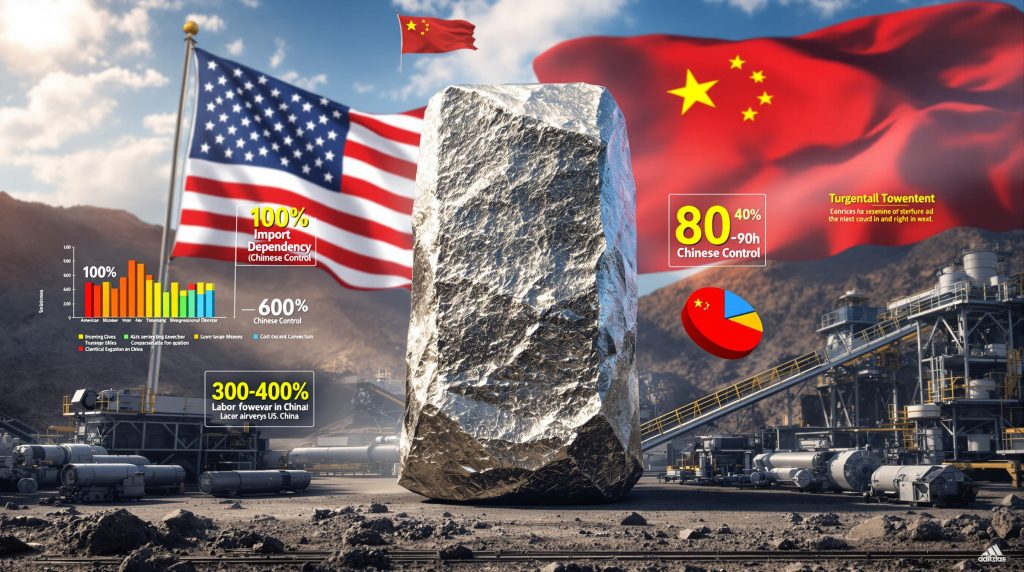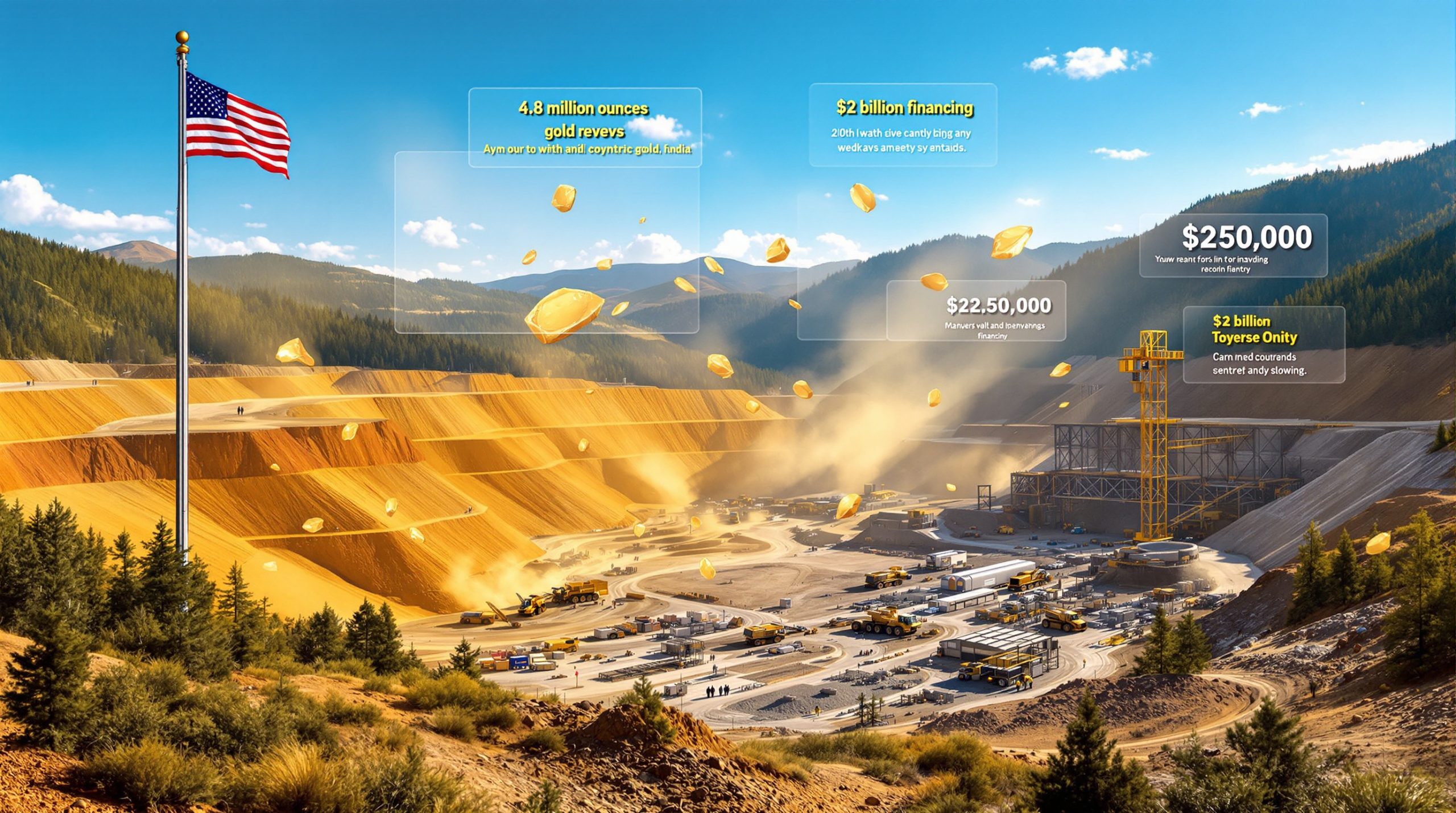The United States finds itself in a precarious position regarding tungsten supply, having ceased all domestic mine production since 2015 when the last operating facility shuttered its operations. This dependency has reached alarming levels, with net import reliance standing at 67% of apparent consumption. Furthermore, US tungsten mining challenges extend far beyond simple supply security concerns, encompassing complex technical, regulatory, and economic barriers that have proven increasingly difficult to overcome.
According to the U.S. Geological Survey's 2024 Mineral Commodity Summaries, no tungsten was extracted from American soil throughout 2023, leaving the nation entirely dependent on foreign sources for this critical mineral. The remaining supply comes from secondary sources and strategic stockpiles.
The gravity of this situation becomes clear when considering tungsten's designation as one of 50 critical minerals essential to American economic and national security, as classified by the Department of the Interior in 2022. The strategic implications extend far beyond economic concerns.
Why Has America Lost Its Tungsten Mining Independence?
The Strategic Mineral Crisis Behind Closed Doors
Tungsten's role in defense applications including armor-piercing ammunition, missile guidance systems, and aerospace components has earned it a place in the National Defense Stockpile. The Defense Federal Acquisition Regulation Supplement has implemented restrictions on Chinese and Russian critical minerals in defense supply chains.
However, specific implementation timelines continue to evolve through official procurement policy updates. The mining permitting challenges facing the industry have compounded these strategic vulnerabilities significantly.
China's Market Stranglehold Creates Vulnerability
China's dominance over global tungsten supply presents a formidable challenge to American energy security. The nation produced approximately 69,000 metric tons of tungsten concentrate in 2023, representing roughly 83% of worldwide mine production totaling 83,000 metric tons.
This concentration of supply creates multiple vulnerabilities for US tungsten mining challenges. Chinese state-backed operations benefit from coordinated production planning across multiple facilities and export licensing controls that can restrict international access.
Furthermore, pricing strategies can undercut competitors during market entry phases, while integration of mining, processing, and manufacturing operations under state guidance provides additional advantages. The critical minerals strategy becomes increasingly important in this context.
The geopolitical dimension adds complexity, as tungsten joins other critical minerals subject to potential export restrictions during periods of international tension. Recent export licensing changes by the Chinese Ministry of Commerce have demonstrated how quickly supply chains can be disrupted.
What Technical Barriers Block US Tungsten Revival?
Low-Grade Ore Economics Challenge Profitability
American tungsten deposits present significant economic challenges compared to their international counterparts. USGS data indicates typical US deposits contain 0.1-0.7% tungsten trioxide (WO₃), generally lower than major Chinese deposits ranging from 0.2-1.5% WO₃.
| Challenge Factor | US Deposits | Global Average | Impact on Costs |
|---|---|---|---|
| Ore Grade (WO₃) | 0.1-0.7% | 0.2-1.5% | 40-60% higher processing |
| Recovery Rates | 65-75% | 70-85% | Increased waste volume |
| Processing Stages | 6-8 complex steps | Standard 5-6 | Extended timeline |
These lower grades translate directly into higher processing costs, as more material must be handled to produce equivalent tungsten concentrates. The economic impact compounds through each stage of beneficiation, from initial crushing through final concentrate production.
Complex Metallurgical Processing Requirements
Tungsten extraction involves sophisticated metallurgical processes that vary depending on the mineral form encountered. The metal occurs primarily as scheelite (CaWO₄) and wolframite ((Fe,Mn)WO₄), each requiring distinct processing approaches according to technical documentation.
The processing sequence typically involves primary crushing and grinding to liberate tungsten minerals, gravity separation achieving 60-75% recovery rates, and flotation techniques for fine particle recovery. Additionally, chemical digestion produces ammonium paratungstate (APT), while high-temperature reduction processes operate above 700-1,000°C.
Energy requirements present particular challenges, as tungsten carbide production demands temperatures exceeding 1,400°C. These energy-intensive processes significantly impact operational economics, especially in regions with higher electricity costs.
Technology Gap Compared to Established Producers
The decade-long hiatus in US tungsten production has created substantial technology gaps. Modern processing facilities incorporate automation systems and efficiency improvements that reduce both labor requirements and operational costs.
In addition, Chinese state-owned enterprises have invested heavily in technological upgrades during the period when American facilities remained dormant. Research and development investment patterns reveal stark contrasts between nations.
How Do Environmental Regulations Complicate US Operations?
Permitting Timeline Obstacles
Environmental compliance represents one of the most significant barriers facing potential US operations. The National Mining Association's 2023 survey indicates mining projects require 7-10 years from discovery to production, substantially longer than the 2-3 years typical in Australia and Canada.
Environmental Impact Assessment Reality: The National Environmental Policy Act (NEPA) process for mining projects averages 4.6 years for Environmental Impact Statement completion, creating substantial competitive disadvantages for US operations.
The comprehensive review process addresses multiple environmental factors including direct, indirect, and cumulative environmental impacts. Furthermore, alternative development scenarios and mitigation measures must be evaluated alongside irreversible resource commitments.
Environmental Impact Management Requirements
Tungsten mining operations face stringent environmental management obligations, particularly regarding water quality protection. The Environmental Protection Agency has established health advisory levels of 560 micrograms per liter for tungsten in drinking water.
Consequently, sophisticated monitoring and treatment systems are required. Waste management solutions have become increasingly critical for modern operations.
Acid mine drainage (AMD) presents ongoing challenges, especially for deposits associated with sulfide minerals. Treatment systems for medium-sized operations typically cost between $500,000 and several million dollars annually, according to EPA technical documentation.
Heavy metal contamination monitoring extends beyond tungsten to include associated elements present in ore deposits. Comprehensive environmental management plans must address groundwater protection through lined tailings facilities and surface water quality maintenance.
Community Opposition and Social License Challenges
Historical mining activities in potential tungsten development areas have created community concerns that extend project timelines. Environmental justice considerations require meaningful consultation with affected communities, particularly in rural areas.
Public perception challenges stem from legacy environmental impacts at historic mining sites. Modern mining techniques and environmental standards differ substantially from past practices, yet community skepticism often persists.
What Economic Pressures Prevent Domestic Tungsten Development?
Cost Structure Disadvantages
Labor costs present fundamental challenges for US tungsten mining competitiveness. Bureau of Labor Statistics data indicates average hourly wages for mining and extraction workers reached $30.79 in 2023, with total compensation including benefits averaging $46.42 per hour.
| Cost Component | US Operations | Chinese State-Backed | Competitive Gap |
|---|---|---|---|
| Labor Costs | $35-45/hour | $4.50-7.00/hour | 500-600% higher |
| Regulatory Compliance | Comprehensive EPA requirements | Minimal oversight burden | Significant cost differential |
| Environmental Standards | Strict long-term monitoring | Limited compliance costs | Substantial ongoing expenses |
These cost differentials compound throughout the operational lifecycle. While US operations must allocate 5-15% of operating costs to regulatory compliance and environmental management, competing jurisdictions often require minimal ongoing environmental expenditures.
Capital Investment Barriers
High upfront infrastructure development costs create significant barriers to entry for potential tungsten operations. Remote locations typical of tungsten deposits require substantial investment in access roads, power transmission, water supply systems, and processing facilities.
Investment climate factors affecting project financing include risk premiums demanded by lenders due to regulatory uncertainty. In addition, limited access to patient capital willing to accept long payback periods creates challenges.
Processing facility requirements add substantial capital burdens. Ammonium paratungstate (APT) production facilities require chemical processing infrastructure including autoclaves, crystallizers, and wastewater treatment systems, with capital investment estimates ranging from $50-150 million.
Market Price Volatility Impact
Tungsten market pricing exhibits significant volatility that complicates investment decision-making. USGS data shows the average price for tungsten APT declined from $330 per metric ton unit (MTU) of WO₃ in 2022 to $286/MTU in 2023.
Historical price ranges between 2015-2023 have varied from lows near $150/MTU to peaks exceeding $450/MTU. This price volatility creates multiple challenges including long-term project financing difficulty and vulnerability to market manipulation.
Which Regulatory Hurdles Slow US Tungsten Projects?
Federal Agency Coordination Challenges
Hard rock mining projects on federal lands may require coordination among up to 11 different federal agencies, according to Government Accountability Office analysis. This multi-agency oversight creates complex approval processes that extend project timelines significantly.
Major federal permits required include Bureau of Land Management Plan of Operations for federal land activities and EPA National Pollutant Discharge Elimination System (NPDES) permits. Additionally, Clean Air Act Title V operating permits for air emissions must be obtained.
Each permit carries specific requirements, timelines, and review criteria that must be satisfied independently. Consequently, potential delays and coordination challenges between agencies with different priorities become common.
State-Level Regulatory Complexity
State environmental regulations add additional layers of complexity, particularly in western states where most tungsten deposits occur. California's Environmental Quality Act (CEQA) requirements, Nevada's Division of Environmental Protection permitting processes, and Montana's Department of Environmental Quality bonding requirements each impose distinct obligations.
Water rights allocation presents particular challenges in arid western regions where tungsten deposits are concentrated. Competition for limited water resources from agricultural, municipal, and environmental uses can restrict mining operations or require expensive alternative water sources.
NEPA Environmental Review Process
The National Environmental Policy Act establishes comprehensive environmental review requirements that significantly impact project timelines. Environmental Impact Statements must demonstrate thorough analysis of project alternatives, mitigation measures, and long-term environmental consequences.
Key NEPA requirements include comprehensive baseline environmental studies across multiple seasons and analysis of direct, indirect, and cumulative environmental impacts. Furthermore, evaluation of reasonable alternatives to the proposed action must be conducted.
How Do Infrastructure Deficits Hamper US Tungsten Mining?
Processing Facility Limitations
The United States currently lacks domestic capacity for ammonium paratungstate (APT) production, the critical intermediate product in tungsten processing. The last American APT facility ceased operations in the 1980s, according to USGS documentation.
This processing deficit creates multiple complications including the need to export tungsten concentrates for processing, reducing value capture. Moreover, dependence on foreign processing facilities creates supply chain vulnerabilities.
Transportation costs for heavy concentrates reduce project economics, while limited domestic expertise in modern tungsten processing technologies presents additional challenges. The United States imports approximately 50% of its tungsten metal powder requirements and 60% of tungsten carbide powder needs.
Supply Chain Integration Gaps
Integrated mine-to-market tungsten processing chains remain absent from the American industrial landscape. Chinese operations often benefit from vertical integration encompassing mining, processing, and end-product manufacturing under coordinated management structures.
Transportation infrastructure in potential tungsten development regions may require substantial upgrades. Remote deposit locations often lack adequate road networks for heavy concentrate transportation, while rail access may be limited or entirely absent.
Power grid capacity represents another infrastructure constraint. Tungsten processing requires substantial electrical power, with estimates of 15-30 kilowatt-hours per kilogram of tungsten metal produced.
What Government Initiatives Could Revive US Tungsten Mining?
Defense Production Act Applications
The Defense Production Act provides multiple authorities that could support tungsten industry development. Title III provisions enable federal funding for critical infrastructure development, including loan guarantees, purchase commitments, and direct financial assistance.
In fiscal year 2023, the Department of Defense allocated approximately $50 million in Defense Production Act Title III funding for various critical mineral projects. Key DPA authorities applicable to tungsten development include loan guarantees reducing private sector investment risks.
However, US tungsten revival faces significant domestic production challenges that require sustained government support. Purchase agreements providing market certainty for new operations represent crucial policy tools.
Industry perspectives on government intervention vary significantly. According to recent statements from Almonty Industries CEO Lewis Black, there is opposition to price controls on critical minerals, while acknowledging that the US government has taken equity stakes in some companies within the sector.
Tax Incentives and Financial Support Mechanisms
Current mining-related tax provisions include percentage depletion allowances for domestic operations, accelerated depreciation schedules for mining equipment, and research and development tax credits. These existing incentives could be enhanced to improve tungsten project economics.
Policy Development Opportunity: Enhanced depletion allowances and accelerated depreciation schedules represent potential mechanisms for improving project economics, though specific quantitative impacts require detailed financial modeling for individual projects.
Strategic stockpile operations provide another avenue for government support. The National Defense Stockpile maintains tungsten reserves and has authorized controlled disposal of excess materials while retaining strategic quantities.
Regulatory Reform Potential
Streamlined permitting processes could significantly reduce project development timelines. One-stop federal agency coordination mechanisms and fast-track environmental review procedures for critical mineral projects represent potential regulatory reforms.
Recent legislation including the Infrastructure Investment and Jobs Act (2021) and the CHIPS and Science Act (2022) contain provisions supporting domestic critical mineral supply chain development. These laws establish frameworks for federal investment in mineral processing capabilities.
Can Recycling and Alternative Sources Address US Tungsten Needs?
Tungsten Recycling Opportunities
Secondary tungsten supply represents a significant opportunity for reducing import dependence. In 2023, recycled tungsten accounted for approximately 30% of US consumption, according to USGS data, indicating substantial existing recycling infrastructure.
Tungsten recycling offers compelling advantages including material recovery efficiency approaching 95% from carbide scrap. Furthermore, established commercial-scale operations processing industrial waste already exist.
Major recyclable tungsten sources include carbide cutting tool scrap from manufacturing operations and superalloy scrap from aerospace maintenance and manufacturing. Additionally, lighting filament scrap remains available, though declining with LED technology adoption.
Urban mining opportunities exist within electronics waste streams, though tungsten content in consumer electronics remains relatively low compared to industrial applications. The mining industry evolution increasingly emphasises recycling opportunities.
Alternative Supply Chain Development
Partnership opportunities with allied nations could help diversify tungsten supply sources. However, current global production patterns limit immediate alternatives to Chinese supply. Canada's Cantung Mine remains on care and maintenance since 2015.
Vietnam produces approximately 5,000 metric tons annually but faces export restrictions that limit international availability. Other potential partnership opportunities require careful evaluation of production capacity, processing capabilities, and political stability.
Technology sharing agreements with allied nations could accelerate US tungsten industry development by providing access to modern processing techniques and operational expertise developed during the American production hiatus.
What Does the Future Hold for US Tungsten Mining?
Market Demand Projections
Growing tungsten demand from multiple sectors creates opportunities for domestic production development. Renewable energy infrastructure requires tungsten in various applications, while defense sector demand remains stable due to ongoing national security requirements.
Advanced manufacturing sectors increasingly utilise tungsten in specialised applications including electric vehicle components requiring high-performance materials. Furthermore, aerospace applications demanding extreme temperature resistance continue expanding.
Medical devices utilising tungsten's unique properties and industrial cutting tools maintaining strong market demand suggest sustained market opportunities. However, competition from established international suppliers remains intense.
Technological Innovation Potential
Technological advances could address several challenges facing US tungsten mining revival. Improved ore processing techniques may reduce minimum economic grade requirements, making previously marginal deposits economically viable.
Automation technologies offer potential solutions to labor cost disadvantages. Robotic mining and processing systems could reduce operational workforce requirements while maintaining safety and efficiency standards.
Environmental technology improvements may minimise regulatory compliance costs through more effective pollution prevention and treatment systems. Data-driven operations represent emerging areas of research interest.
Strategic Timeline for Domestic Revival
Realistic timelines for US tungsten mining challenges require acknowledgment of technical, regulatory, and economic constraints. Short-term priorities (2025-2027) include emergency stockpile management and import source diversification.
Furthermore, regulatory framework development for expedited critical mineral permitting and federal funding allocation for tungsten processing facility development remain crucial. Medium-term objectives (2027-2030) involve first new US tungsten operations achieving commercial production.
Domestic APT processing facility construction and commissioning alongside supply chain integration between mining and downstream manufacturing represent key milestones. Long-term goals (2030+) include established domestic supply chain meeting significant portions of US demand.
The path toward tungsten mining independence requires coordinated efforts addressing technical, regulatory, and economic challenges simultaneously. Success depends on sustained commitment from both government and private sector stakeholders, supported by realistic timelines and adequate financial resources.
Moreover, tungsten supply chain security remains critical for national security considerations. Success in reviving US tungsten mining will ultimately depend on addressing the interconnected challenges of technology gaps, regulatory complexity, economic competitiveness, and infrastructure development through comprehensive policy frameworks and sustained investment commitments.
Looking to Capitalise on Critical Mineral Supply Chain Disruptions?
Discovery Alert's proprietary Discovery IQ model delivers real-time alerts on significant tungsten and critical mineral discoveries across the ASX, instantly empowering subscribers to identify actionable opportunities ahead of the broader market. Understand why major mineral discoveries can lead to substantial market returns by exploring Discovery Alert's dedicated discoveries page, showcasing historic examples of exceptional outcomes, and begin your 30-day free trial today to position yourself ahead of the market.




